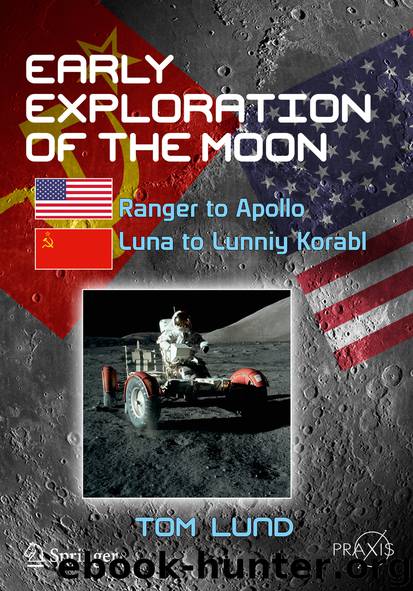Early Exploration of the Moon by Tom Lund

Author:Tom Lund
Language: eng
Format: epub
ISBN: 9783030020712
Publisher: Springer International Publishing
Reaction Control System in Command Module
The reaction control system in the Command Module enabled attitude control after the Command Module separated from the Service Module just before reentering the earth’s atmosphere. Attitude of the spacecraft relative to the velocity vector was critical for successful entry into the atmosphere.
The Command Module contained two independent reaction control subsystems for redundancy referred to as subsystem 1 and subsystem 2. Each subsystem had a separate set of six rocket engines directed to provide clockwise roll, counterclockwise roll, +pitch, −pitch, +yaw, and -yaw.
The reaction engines were 11.7 inches long, and the nozzle exit diameter was 2.13 inches. Each engine generated 93 pounds of thrust. The engines were mounted internally with exits of the engines flush with the outer surface of the Command Module. Since the engines were mounted internally, they were ablatively cooled and that limited their operating life. The engines, which were rated for service life of 200 seconds and 3,000 operational cycles, were developed and built by the Rocketdyne Division of North American Aviation.
The engines used monomethyl hydrazine (MMH) for fuel and nitrogen tetroxide (N2O4) as the oxidizer. This combination ignited upon contact with one another. Each of the two redundant reaction systems had a fuel tank, an oxidizer tank, and a helium tank. Helium was used to pressurize the fuel and oxidizer. The helium tank was about 9 inches in diameter and contained helium at a pressure of 4,150 psi. A pressure regulator reduced the pressure to about 180 psi to pressurize the fuel and oxidizer tanks.
Fuel was contained in cylindrical tanks 17 inches long and 12.5 inches in diameter with hemispheric domes. The tanks were built out of titanium alloy. Each tank held 45 pounds of fuel. The oxidizer tank was similar to the fuel tank but 3 inches longer at 20 inches long. Each oxidizer tank held 89 pounds of oxidizer. The tanks had Teflon bladders that held the fuel and oxidizer. When helium pressure was applied to the tanks, it squeezed the bladder and forced the propellants into manifolds that fed the engines.
The fuel and oxidizer lines connected to feed injector valves near each engine. The injector valves were spring loaded closed, and they were opened to admit propellants by energizing solenoid coils. There were two sets of coils in each injector, one for automatic control and one for direct control from the hand rotational controller. Control signals for the automatic solenoid coils were generated by the Reaction Jet Engine ON-OFF Control Assembly (RJ/EC).
The engines could be pulse fired for short impulses lasting less than 70 milliseconds or fired continuously for several seconds. Input signals from the guidance computer instructed operation of the RJ/EC when the spacecraft was under computer control, and signals from the Electronic Control Assembly instructed operation of the RJ/EC when the spacecraft was being controlled by the stabilization and control system.
A backup manual control mode could be selected by the astronauts by turning the “Direct RC” switch on the instrument panel to the ON position.
Download
This site does not store any files on its server. We only index and link to content provided by other sites. Please contact the content providers to delete copyright contents if any and email us, we'll remove relevant links or contents immediately.
| Automotive | Engineering |
| Transportation |
Whiskies Galore by Ian Buxton(41720)
Introduction to Aircraft Design (Cambridge Aerospace Series) by John P. Fielding(33016)
Small Unmanned Fixed-wing Aircraft Design by Andrew J. Keane Andras Sobester James P. Scanlan & András Sóbester & James P. Scanlan(32684)
Craft Beer for the Homebrewer by Michael Agnew(18081)
Turbulence by E. J. Noyes(7894)
The Complete Stick Figure Physics Tutorials by Allen Sarah(7264)
Kaplan MCAT General Chemistry Review by Kaplan(6822)
The Thirst by Nesbo Jo(6758)
Bad Blood by John Carreyrou(6476)
Modelling of Convective Heat and Mass Transfer in Rotating Flows by Igor V. Shevchuk(6353)
Learning SQL by Alan Beaulieu(6158)
Weapons of Math Destruction by Cathy O'Neil(6084)
Man-made Catastrophes and Risk Information Concealment by Dmitry Chernov & Didier Sornette(5877)
Digital Minimalism by Cal Newport;(5586)
Life 3.0: Being Human in the Age of Artificial Intelligence by Tegmark Max(5404)
iGen by Jean M. Twenge(5325)
Secrets of Antigravity Propulsion: Tesla, UFOs, and Classified Aerospace Technology by Ph.D. Paul A. Laviolette(5237)
Design of Trajectory Optimization Approach for Space Maneuver Vehicle Skip Entry Problems by Runqi Chai & Al Savvaris & Antonios Tsourdos & Senchun Chai(4957)
Electronic Devices & Circuits by Jacob Millman & Christos C. Halkias(4865)
